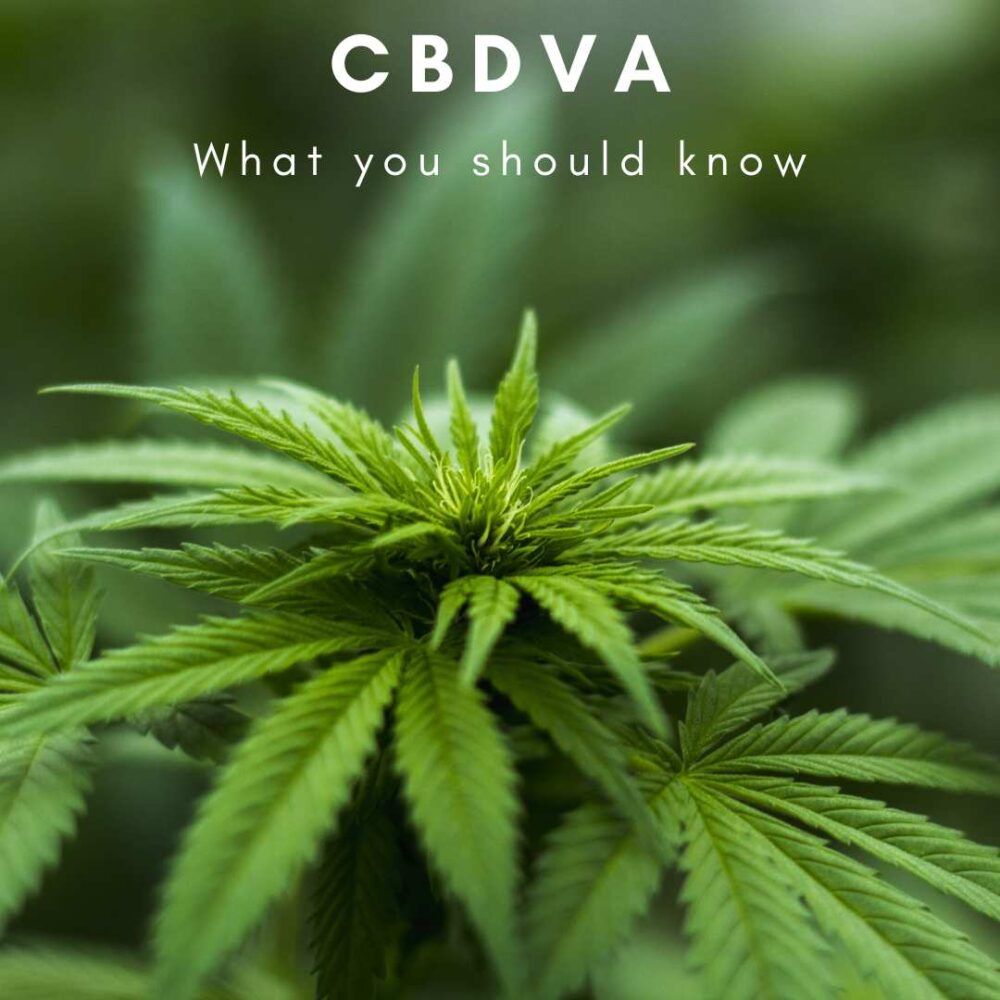
You may have already heard about CBDA (cannabidiolic acid) and its benefits, but there are many more minor acidic cannabinoids that are in the hemp plant. In this article, learn about CBDVA, a unique, naturally occurring acidic cannabinoid found in the cannabis plant.
What are the current and future potential uses for this CBDVA?Article Highlights
- CBDVA is a non psychoactive cannabinoid found in the hemp plant
- CBDVA is the precursor to CBDV, and has some similar properties to CBDA and CBD
- The CBDVA compound is not found in high amounts in most hemp plant species.
What is CBDVA
Like all cannabinoids, cannabidivarinic acid (CBVDA) is the starting compound for its decarboxylated form, cannabidivarin (CBDV). The most common cannabinoid in hemp is CBDA, but the other minor cannabinoids can vary in amount depending on the strain and growing conditions. In fact, CBDV has a very similar structure to its chemical cousin CBD (cannabidiol).
How acidic cannabinoids start
While all cannabinoids start out in the acidic form, they all come from one of two closely related common ancestors, CBGA (cannabigerolic acid) or CBGVA (cannabigerovarinic acid). CBGA is well known since it is directly converted by multiple synthase enzymes into THCA (tetrahydrocannabinolic acid), CBDA, or CBCA (cannabichromenic acid).
CBGA and CBDVA are referred to as the "stem cells" of the cannabinoids, since they are used to produce all the other cannabinoids.
The similarity between CBGVA and CBGA is alarmingly close, and the only difference is in the length of the carbon side chain. CBGVA can produce three other "varin" cannabinoids, CBDVA, CBCVA and THCVA through the same enzymes that convert CBDA to its downstream cannabinoids. See the below figure showing how close the structures are between CBGVA and CBGA:
Chemically, the synthesis difference between the starting compounds CBGVA and CBGA is the use of divarinolic acid and olivetolic acid when the compounds are created. Interestingly, the same enzyme synthesizes both CBGVA and CBGA, indicating that the difference in amount of the divarinolic and olivetolic acid inside the plant cells determines what is produced.
Basics of CBDVA
Like all other "varin" cannabinoids, CBDVA inherits the short, 3 carbon side chain unique to this class of hemp compounds.To understand how CBDV and other decarboxylated cannabinoids are derived, lets take a look at the acidic cannabinoids. The common structure for the acidic form is the presence of a carboxylic group, which consist of 2 oxygens, a carbon, and a hydrogen. For example, see below for the difference between CBDVA and CBDV, which shows the loss of a carboxylic acid on the right side of the molecule:

Background of CBDVA and acidic cannabinoids
Almost all of the cannabinoids found in cannabis sativa, or other hemp plants, are in the acid forms, such as cannabidiolic acid or cannabidivarinic acid. The carboxylated compounds are natural products and synthesized mostly in the flower and trichromes of cannabis plants. The cannabis sativa plants can have over 100 different cannabinoids.
Why have I not seen CBDVA or other acidic cannabinoids?
The acidic cannabinoid product has been missing from the market for a number of reasons:- The evidence from the marijuana industry and from customers found that you need to decarboxylate THCA (non psychoactive cannabinoid) into THC to get a strong "treatment effect" from the plant. This led to the idea that you need to decarboxylate cannabinoids to "activate" them.
- Almost all extraction and purification methods for marijuana and now hemp plants involved the use of heat. Because of this, the precursor acidic compounds were destroyed in the process. Almost all of the R&D in the hemp space has now involved scaling up and iterating on the basic processing technologies that have been around since the mid 1990's.
- Because of the two reasons above, most of the preclinical and clinical research has focused on CBD and THC, and the acidic forms were not as well investigated. This is changing, and many laboratories have now demonstrated compelling results suggesting new therapeutic potentials for CBDVA and other acidic cannabinoids.
While some hemp plants contain more CBDVA than other strains, it still remains somewhat of a minor cannabinoid. It can be difficult to find a tincture or product with high acidic cannabinoids and CBDVA but there are a few, such as Natural Dos tinctures.
Research on CBDVA health benefits
Similar to many minor cannabinoids, cannabidivarinic acid CBDVA has only a limited amount of research and preclinical studies assessing its potential health benefits.
Enhanced absorption of CBDVA
Similar to CBDA, which has over 500-1000% better absorption than CBD, CBDVA also shows significant absorption properties. A recent study in mice, which looked at the ability of acidic cannabinoids like cannabidivarinic acid to be absorbed, found that CBDVA was able to reach a maximum plasma concentration in the low microgram per milliliter (11-26) range.
This enhanced absorption of CBDVA should be compared to a normal range for decarboxylated forms that are almost 100 times lower in the 10-100 nanogram per milliliter range. This has significant implications for its health benefits, since you have to take substances at much higher doses if their absorption is low.
CBDVA Anti convulsion therapy
With the success of CBD in treatment of refractory epileptic patients, similar cannabinoids are being tested for their potential use. CBDVA, was recently tested in in vitro for its potential actions on calcium channels, a ubiquitous class of membrane proteins that control nerve cell excitability. Using certified reference material for validation, these studies found that both CBGVA and CBDVA could inhibit a T subclass of calcium channels preventing abnormal excitation of neurons.
CBDVA as a precursor to CBDV
It is difficult to find CBDVA only products, or products with high amounts of CBDVA for consumption. The CBDVA testing methods show that it can be easily decarboxylated, and thus lose its rapid absorption properties that make acidic cannabinoids so potent.
However, CBDV itself has some significant health properties that have been reported.
CBDV and anti convulsion
Similar to CBDVA, CBDV also showed significant benefit in improving outcomes in epileptic models. CBDV was found to decrease seizures in multiple models using mice and rats, and was also seen to be additive when used in combination with CBD.
Muscle activation and growth
One of the receptors involved in the endocannabinoid system is TRPV1, an important Ca+ channel implicated in Duchenne muscular dystrophy (DMD), a genetic disease that causes muscle wasting. The effect of CBDV and CBD on muscle cells from DMD patients were tested, and found to increase muscle growth and expansion.
CBDV and brain atrophy
Rett syndrome is a genetic disease characterized by behavioral alterations and slow brain atrophy. Recent identification of a novel endocannabinoid receptor (GPR55) that is associated with the disease led scientists to test if CBDV could improve outcomes in a model of Rett syndrome.
Using intraperitoneal administration of CBDV, researchers found that brain atrophy was improved, as was motor skills in a mouse model of this disease. Activation of GPR55 associated pathways was implicated since this protein was found to be increased in the brain after CBDV therapy.
How to find find the best CBDVA
When looking for top hemp products with CBDVA, it will be difficult to find, since the products typically only have CBDV, and at low quantities. Many companies are working on cloning hemp strains that have a suitable amount of CBDVA, but these are not ready to be on the market yet.You may find products with CBDV instead, but be sure to check the Certificate of Analysis by a reputable third party testing lab. See our CoA guide for assistance in how to interpret the testing results.
Natural Dos has isolated all the acidic cannabinoids from the hemp plant, and this includes CBDVA. However, since the current plants do not produce high amounts of CBDVA, there is only a small amount of it present in our products.

